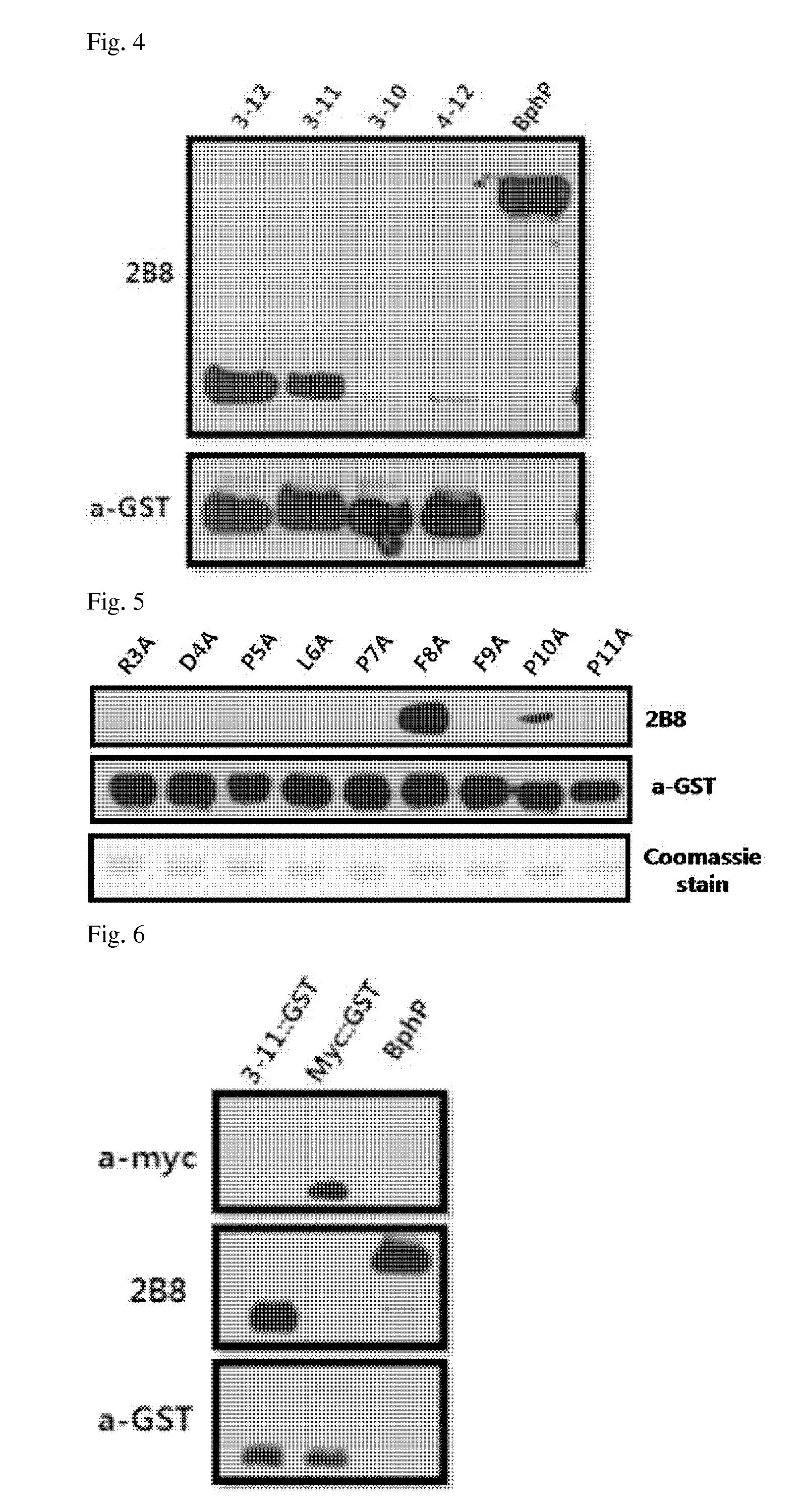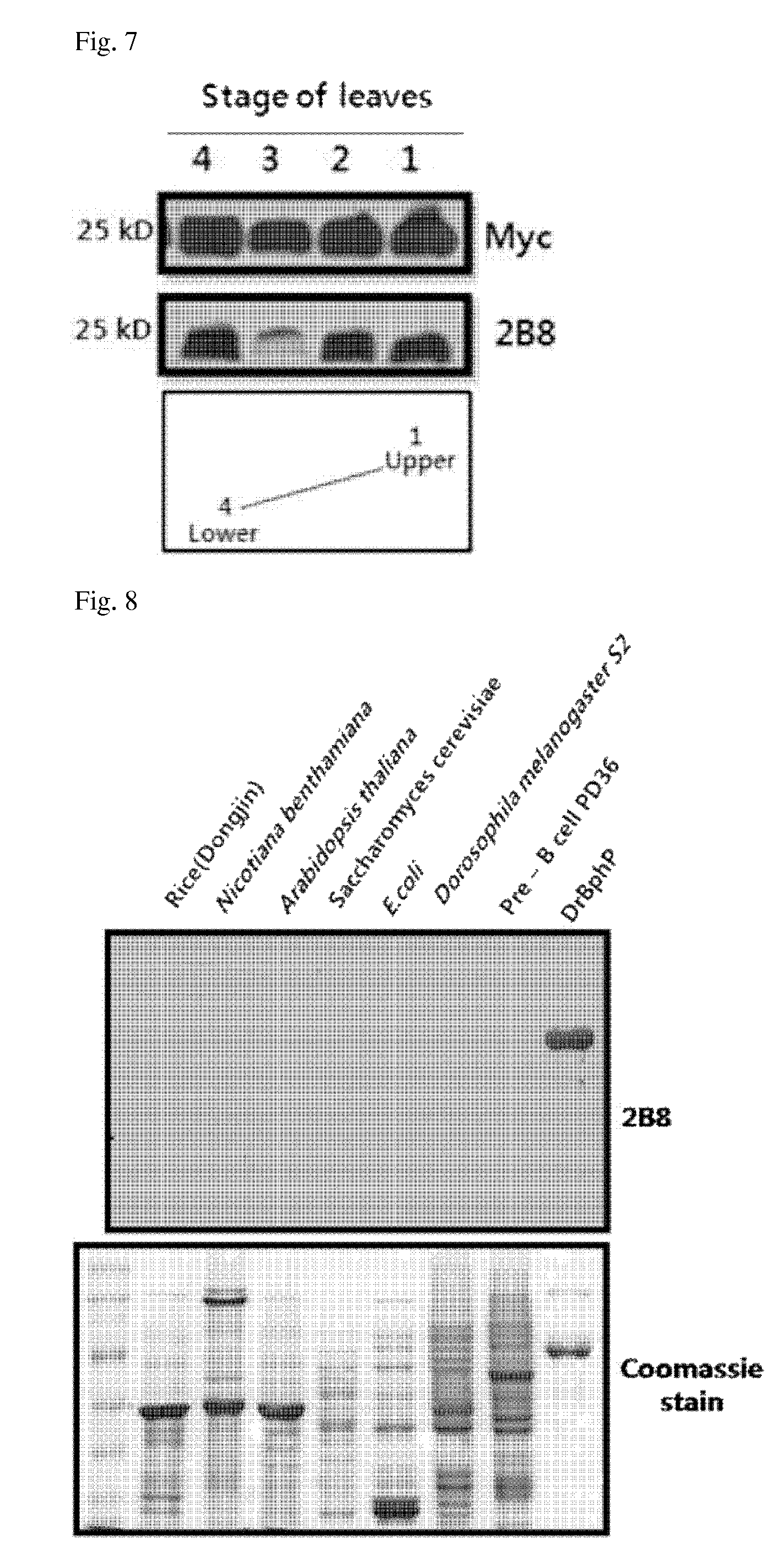Peptide tag and uses thereof
a peptide and tag technology, applied in the field of peptide tag and its use, can solve the problems of limited output, uneconomical in terms of cost and time, and difficult to purify the target protein without the corresponding antibodies, and achieve the effect of short length, effective detection or purification, and removal of non-specific reactions
- Summary
- Abstract
- Description
- Claims
- Application Information
AI Technical Summary
Benefits of technology
Problems solved by technology
Method used
Image
Examples
example 1
Cloning of BphP Gene and BphN Gene of Deinococcus radiodurans
[0046]A gene (SEQ ID NO: 4) encoding the whole length of Bacterophytochrome protein (BphP) of Deinococcusradiodurans and a gene (SEQ ID NO: 5) encoding polypeptide (BphN) having amino acids located at 1 to 321 locations based on N-terminal of DrBphP were cloned by using a PCR. Specifically, the PCR was performed about 30 cycles by using a gene (SEQ ID NO: 4) encoding the whole length of Bacteriophytochrome protein (BphP) of Deinococcusradiodurans as a template, primers for cloning the BphP gene or primers for cloning the BphN gene, and Ex-Taq (TAKARA) polymerase to obtain the amplified BphP DNA product and BphN DNA product. The primers used for obtaining the amplified BphP DNA product and BphN DNA product are listed in the following Table 1. The primers listed in the following Table 1 and all the primers to be described below were prepared by asking to Bioneer co. (KR).
[0047]
TABLE 1Restriction enzymeSEQrecognition siteID ...
example 2
Expression of BphP Protein and BphN protein of Deinococcus radiodurans
[0050]Colonies transformed to the BL21 competent cell and grown on the LB medium were inoculated to a LB medium including kanamycin, and then seed-cultured at 37° C. for about 8 hours. The seed-cultured cells were inoculated in the LB medium including kanamycin; the cells were cultured until a value measured at OD600 became 0.6; then IPTG (isopropyl-1-thio-β-D-galactopyranoside) was added to be 0.5 mM of the total concentration; and the protein expression was induced at 25° C. for 6 hours. Since then, the cells were centrifuged to remove supernatant and then pellet was re-suspended in a binding buffer (100 mM of Tris-Cl, 150 mM of NaCl, and 10 mM of imidazole, pH 8.0). Then, the re-suspended pellet was sonicated to break the cells, again centrifuged to remove only supernatant, and then the protein was purified by using a Ni+-NTA column (QIAGEN). Since then, the purified protein was stored at −70° C.
[0051]Since th...
example 3
Preparation of Monoclonal Antibody Specifically Binding to BphP Protein and BnhN Protein of Deinococcus radiodurans
[0052]3-1: Immune Treatment
[0053]The purified BphP protein or BphN protein as an antigen was mixed with a complete Freund's adjuvant, and then injected into the abdominal cavity of a 6-week female BALB / c mouse. An immersion was mixed by using a vortexer for 1 hour, then mixed with an incomplete Freund's adjuvant and an antigen by using the same method as described above, and then injected into the abdominal cavity. After 2 weeks, blood was collected from the tail of mouse and tested by using a ELISA. When an antibody titer is 1.0 or more at 1 / 1000, the blood was used for a cell fusion. At 4 weeks from a secondary immune treatment for the cell fusion, the equivalent antigen was diluted with a PBS, and then injected into the abdominal cavity. After 3 days, the mouse was sacrificed and then subjected to the cell fusion.
[0054]3-2: Cell Fusion for Production of Monoclonal A...
PUM
| Property | Measurement | Unit |
|---|---|---|
| pH | aaaaa | aaaaa |
| constant temperature | aaaaa | aaaaa |
| temperature | aaaaa | aaaaa |
Abstract
Description
Claims
Application Information
 Login to View More
Login to View More - R&D
- Intellectual Property
- Life Sciences
- Materials
- Tech Scout
- Unparalleled Data Quality
- Higher Quality Content
- 60% Fewer Hallucinations
Browse by: Latest US Patents, China's latest patents, Technical Efficacy Thesaurus, Application Domain, Technology Topic, Popular Technical Reports.
© 2025 PatSnap. All rights reserved.Legal|Privacy policy|Modern Slavery Act Transparency Statement|Sitemap|About US| Contact US: help@patsnap.com



